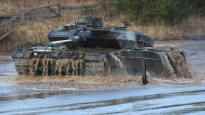According to Chancellor Olaf Scholz, the caution was justified. Still, Germany’s actions already enraged the European allies, writes Europe correspondent Suvi Turtiainen.
Suvi TurtiainenEurope correspondent
BERLIN Germany’s Leopard decision is a strong message to Russia. Western allies are ready to arm Ukraine with heavy battle tanks to turn the course of the war in Ukraine’s favor.
In addition, the decision to send a message to the German Chancellor By Olaf Scholz to reviewers. From Scholz’s point of view, waiting and chasing for weeks paid off, because with persistent diplomacy, the United States was also included in the battle tank alliance.
The United States has been reluctant to hand over its own Abrams battle tanks to Ukraine partly because of the challenging usability of the tanks. For Germany, according to the United States, entry was a threshold issue.
At the weekend, the German newspaper Süddeutsche Zeitung report (you switch to another service) The US Defense Minister’s delegation was already nervous about the coldness of Germany. Chancellor Scholz’s cabinet made it abundantly clear to the delegation that visited Berlin last week that Germany will not release the Leopards unless a corresponding decision comes from the United States. The United States did not accept the condition at that time.
So the decision to send the Leopards was not reached at last week’s coordination meeting of Ukraine’s arms aid in Ramstein.
A few days later, a diplomatic agreement seems to have been reached.
Wednesday evening Finnish time Joe Biden reported that the United States will give Ukraine 31 Abrams main battle tanks. Officials interviewed by The New York Times by (you switch to another service) the decision was influenced specifically by the condition set by Germany.
US involvement was a turning point for Germany, as the United States brings with it the world’s largest security guarantee. In Germany, the fear has been Russia’s possible backlash to sending battle tanks. Now the Kremlin’s possible backlash must also be aimed at the United States.
Olaf Scholz repeated the reason for caution in his speech to the parliament on Wednesday: Germany is ready to support Ukraine, but the war must not be allowed to escalate into a war between Russia and NATO.
– We take care that NATO will not be drawn into a war with Russia, Scholz said when justifying the Leopard decision.
Scholz’s reluctance to comment on the reasons for the fight already had time to eat away at the confidence of the European allies in Germany. Leadership and a clear vision would have been expected from Germany, but Scholz chose to influence behind the scenes without clear public statements.
Rest of Europe had to speculate for weeks whether Germany was going to send Leopards at all. Poland already had time to announce that it is ready to send Leopards to Ukraine, even without the export license of Germany, the country of manufacture.
There was an explanation for Jahkailu, but not for why Olaf Scholz communicated his goals catastrophically weakly even to his close allies in this question as well.
There are clear historical reasons for caution in Germany. For many Germans, the thought of German battle tanks – albeit in Ukrainian hands – facing off against Russian tanks is an abomination. It evokes echoes of the Second World War, when Germany was the aggressive aggressor state in Europe, and in the same countries millions died in the battles between Nazi Germany and the Soviet Union.
Speaking to the parliament, Scholz also sent a direct message to worried Germans. According to him, the Leopard decision does not increase the risk facing Germany, because Germany coordinates its decisions in international cooperation.
– Trust me, trust the government, Scholz said on Wednesday.
Decision in Germany can be considered historical. By sending the Leopards, Germany publicly acknowledges that the defense of Ukraine also requires an offensive force, at least when the goal is to regain the territories occupied by Russia.
The recent US Abrams decision may be mostly symbolic at this point. Media information by (you switch to another service) It could take the US months to years to get battle tanks to Ukraine.
Germany’s decision, on the other hand, frees smaller European countries to decide on their own participation in the Leopard combat system to be delivered to Ukraine.
Finland’s political leadership has made it clear that Finland is involved in the Leopard coalition. In what way, we will decide next. Finland’s policy has been to hide the detailed information about the arms aid to Ukraine.
What thoughts did the story evoke? You can discuss the topic on 26.1. until 11 p.m.
